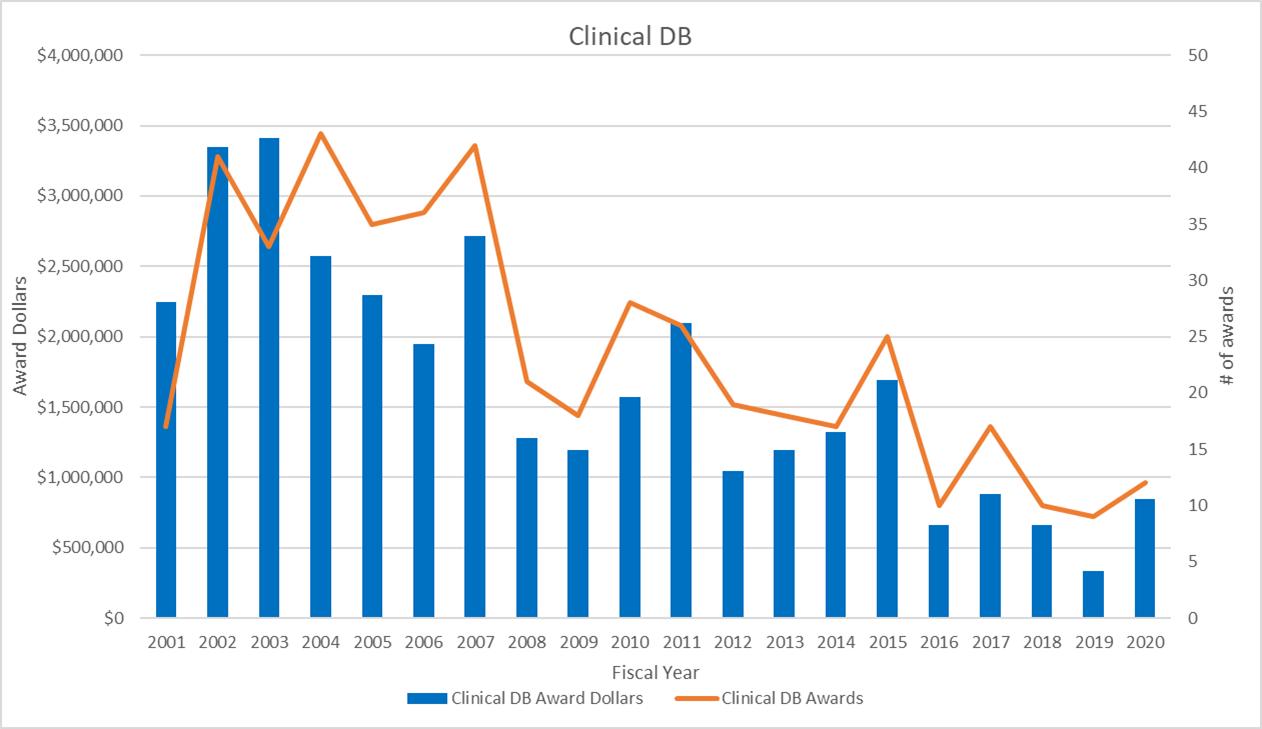Two decades ago, NIH launched a duo of loan repayment programs (LRPs) to recruit and retain qualified health professionals into research on health disparities. Now, as we celebrate the 20th anniversary of the Health Disparities Research LRP (LRP-HDR) and Clinical Research LRP for Individuals from Disadvantaged Backgrounds (LRP-IDB), we wanted to share some data, highlight a new extramural LRP, and send a reminder that the LRP application cycle opens on September 1st.
At the start of the LRP-HDR in fiscal year (FY) 2001, NIH funded $3.1 million towards the program, supporting 28 awards (Figure 1). All funding data presented here and in Figure 2 are inflation-adjusted, using 2020 as the base. Funding and awards for this program reached a high point in FY 2007 at $18.48 million (293 awards). After a decade of steady decline, there was a striking rise in funding to $12.95 million in FY 2020 (171 awards).
Figure 1 – LRP-HDR Funding and Awards: FY 2001-2020
This increase seen in FY 2020 was due to the expansion of the LRP-HDR to all NIH Institutes and Centers, not only the National Institute for Minority Health and Health Disparities. Previously, the National Institute for Minority Health and Health Disparities was the sole funder of this LRP, meaning the LRP needed to compete with other programs at the Institute for resources.
The reverse in the downward trend for this program was exactly the intent behind the expansion. As Dr. Ericka Boone, Director of the OER’s Division of Loan Repayment and Acting Director of the Division of the Biomedical Research Workforce, notes in her blog, “during the first year of expanded NIH Institute and Center participation, 171 applicants received an award from 20 Institutes and Centers, which represented more than double the 83 awards made the year before. It also represented the LRP-HDR’s highest success rate (36%) since FY 2014.”
Figure 2 shows the funding and award data for the LRP-IDB. Note that Figure 2’s Y axes have smaller ranges than Figure 1. In FY 2001, NIH made 17 awards, totaling $2.25 million. Fast forwarding to last year, $843,000 was spent on 12 LRP-IDB awards.
Figure 2 – LRP-IDB Funding and Awards: FY 2001-2020
These two programs underscore our wider efforts to strengthen and diversify the biomedical workforce. They also complement the research supported by the other available LRPs, with yet another notable extramural LRP starting this Fall.
The Research on Emerging Areas Critical to Human Health (REACH) LRP will target major opportunities and gaps in biomedical research (as identified by the participating NIH Institute or Center) and expand research in emerging areas of human health. Check out the guide notice for more on this program.
We strongly encourage eligible scientists to consider applying for the HDR, IDB, REACH, or another Extramural LRP that aligns with your research interest. LRP recipients can receive up to $50,000 per year to repay qualified educational debt, along with other professional benefits. The application cycle opens on September 1st and closes November 18th.
Please be sure to review the mission and research priorities for each NIH Institute and Center (see this post), as well as contact relevant NIH LRP liaisons early and often to discuss your research and career interests. You can also watch these videos as well as listen to these two NIH All About Grants podcasts that share advice and an overview on the LRPs and tips for the application itself to get more useful insights on the process.





0 Comments